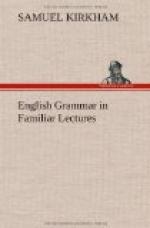The same rule and restrictions apply, when two or more nouns refer to the same preposition; as, “He was composed both under the threatening, and at the approach, of a cruel and lingering death;” “He was not only the king, but the father of his people.”
5. The words, “as, thus, nay, so, hence, again, first, secondly, formerly, now, lastly, once more, above all, on the contrary, in the next place, in short,” and all other words and phrases of a similar kind, must generally be separated from the context by a comma; as, “Remember thy best friend; formerly, the supporter of thy infancy; now, the guardian of thy youth;” “He feared want; hence, he overvalued riches;” “So, if youth be trifled away,” &c. “Again, we must, have food and clothing;” “Finally, let us conclude.”
The foregoing rules and examples are sufficient, it is presumed, to suggest to the learner, in all ordinary instances, the proper place for inserting the comma; but in applying these rules, great regard must be paid to the length and meaning of the clauses, and the proportion which they bear to one another.
SEMICOLON.
The semicolon is used for dividing a compound sentence into two or more parts, not so closely connected as those which are separated by a comma, nor yet so little dependant on each other, as those which are distinguished by a colon.
RULE 1. When the preceding member of the sentence does not of itself give complete sense, but depends on the following clause, and sometimes when the sense of that member would be complete without the concluding one, the semicolon is used; as in the following examples: “As the desire of approbation, when it works according to reason, improves the amiable part of our species; so, nothing is more destructive to them, when it is governed by vanity and folly;” “The wise man is happy, when he gains his own approbation; the fool, when he gains the applause of those around him;” “Straws swim upon the surface; but pearls lie at the bottom.”
Exercises.—The path of truth is a plain and safe path that of falsehood a perplexing maze. Heaven is the region of gentleness and friendship hell of fierceness and animosity. As there is a worldly happiness which God perceives to be no other than disguised misery as there are worldly honors which in his estimation are reproach so there is a worldly wisdom which in his sight is foolishness.
But all subsists by elemental strife
And passions are the elements of life.
RULE 2. When an example is introduced to illustrate a rule or proposition, the semicolon may be used before the conjunction as; as in the following instance: Prepositions govern the objective case; as, “She gave the book to him.”
NOTE. In instances like
the foregoing, many respectable punctuists
employ the colon, instead
of the semicolon.




